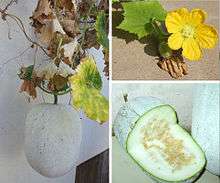Winter melon
| Nutritional value per 100 g (3.5 oz) | |
|---|---|
| Energy | 54 kJ (13 kcal) |
|
3 g | |
| Dietary fiber | 2.9 g |
|
0.2 g | |
|
0.4 g | |
| Vitamins | |
| Thiamine (B1) |
(3%) 0.04 mg |
| Riboflavin (B2) |
(9%) 0.11 mg |
| Niacin (B3) |
(3%) 0.4 mg |
| Pantothenic acid (B5) |
(3%) 0.133 mg |
| Vitamin B6 |
(3%) 0.035 mg |
| Vitamin C |
(16%) 13 mg |
| Minerals | |
| Calcium |
(2%) 19 mg |
| Iron |
(3%) 0.4 mg |
| Magnesium |
(3%) 10 mg |
| Manganese |
(3%) 0.058 mg |
| Phosphorus |
(3%) 19 mg |
| Sodium |
(7%) 111 mg |
| Zinc |
(6%) 0.61 mg |
|
| |
| |
|
Percentages are roughly approximated using US recommendations for adults. Source: USDA Nutrient Database | |
The winter melon, also called ash gourd,[2] white gourd, winter gourd, tallow gourd,[2] and Chinese preserving melon[2] is a vine grown for its very large fruit, eaten as a vegetable when mature.
It is the only member of the genus Benincasa. The fruit is fuzzy when young. The immature melon has thick white flesh that is sweet when eaten. By maturity, the fruit loses its hairs and develops a waxy coating, giving rise to the name wax gourd, and providing a long shelf life. The melon may grow as large as 80 cm in length. Although the fruit is referred to as a "melon," the fully grown crop is not sweet. It has yellow flowers and broad leaves.[3]
It is native to South Asia and Southeast Asia. The winter melon is widely grown throughout Asia,[4] including Java and Japan[5] where it is thought to have originated from.[3]
Winter melon is also a common name for members of the Inodorus cultivar group of the muskmelon (Cucumis melo L), more commonly known as casaba or honeydew melons.
Cultivation
It is grown in well drained loam and sandy soils, in warm mild climates, but will not tolerate frosts. The crops are grown in riverbeds or furrows, and needs constant irrigation during the growing season.[3]
Uses
The winter melon requires very warm weather to grow but can be stored for many months much like winter squash. Ash gourds of the Indian subcontinent have a white coating with rough texture. South East Asian varieties have a smooth waxy texture. It is one of the few vegetables available during winter in areas of deciduous vegetation, hence its Chinese name literally means 'winter melon'. The winter melon can typically be stored for 12 months. In India, ash gourd is recognized for its medicinal properties in the Ayurvedic system of medicine.[5]
In Vietnamese cuisine, it is called bí đao, which is usually used to make soup or stew.[6] When cooked with pork short ribs, the resulting soup is traditionally thought to help produce more milk for breastfeeding mothers.
In Chinese cuisine the melons are used in stir fry or usually combined with pork or pork/beef bones to make winter melon soup, often served in the scooped out melon, carved by scraping off the waxy coating. It is also chopped and candied[7] as wintermelon candy (táng dōng guā) to be commonly eaten at New Year festivals, or as filling for Sweetheart cake (lǎopó bǐng). It has also been used as the base filling in Chinese and Taiwanese mooncakes for the Moon Festival.
Winter melon is candied (referred to plainly as kundol) and is used as a pastry filling for bakpia (hopia in the Philippines). It is also an ingredient in some savory soups (sabaw) and stir-fries (guisado). It is one of the vegetables mentioned in the Filipino folk song "Bahay Kubo."
In Indian cuisine the vegetable is traditionally used to prepare a wide variety of dishes. In northern India it is used to prepare a candy called Petha. In South Indian cuisine, it is traditionally used to make a variety of curries, including a liquefied dish with curds or buttermilk.[8] The juice of raw ash gourd is used by the Mizo community of North-East India as a natural remedy to treat mild to severe dysentery.
Occasionally, it is used to produce a fruit drink with a very distinctive taste. It is usually sweetened with caramelized sugar. In Southeast Asia, the drink is widely marketed as winter melon tea or winter melon punch.
The shoots, tendrils, and leaves of the plant may also be eaten as greens.[9]
Gallery
 Nearly mature winter melon
Nearly mature winter melon Winter melon
Winter melon Seeds
Seeds Indian Ash gourd on the vine.
Indian Ash gourd on the vine. Chinese winter melon soup
Chinese winter melon soup
See also
- Double steaming for a Cantonese dish called Winter melon urn (冬瓜盅).
References
- ↑ "The Plant List: A Working List of All Plant Species". Retrieved April 10, 2014.
- 1 2 3 , "Multilingual Multiscript Plant Name Database". Retrieved 10 April 2014.
- 1 2 3 D. K. Salunkhe and S. S. Kadam (Editors)Handbook of Vegetable Science and Technology: Production, Composition, Storage and Processing, p. 290, at Google Books
- ↑ "Benincasa hispida - Plant Finder". www.missouribotanicalgarden.org.
- 1 2 T. R. Gopalakrishnan Vegetable Crops, p. 138, at Google Books
- ↑ "Winter Melon Soup - Canh Bí Đao". youtube.com. 30 August 2014. Retrieved 1 June 2017.
- ↑ "How to make Candied Winter Melon aka Tung Kua(冬瓜糖)". 2009. Retrieved 18 December 2011.
- ↑ Pratnee (8 March 2009). "Budidagummadikay MajjigaPulusu".
- ↑ "~Winter Squash Leaves in Salted Coconut Milk". praneesthaikitchen.com. 9 August 2011. Retrieved 2 June 2017.
External links
 Media related to Benincasa hispida at Wikimedia Commons
Media related to Benincasa hispida at Wikimedia Commons
